HOW CAN WE HELP YOU? Call 1-800-TRY-CHOP
In This Section
Tour the Cores: Aquatic Zebrafish Core and its Underwater Superheroes
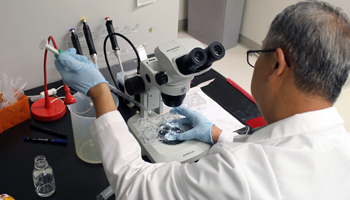 By Nancy McCann
By Nancy McCann
Recent headlines have turned wee creatures called zebrafish into underwater superheroes: “The Boy Was Dying. Zebrafish Helped Save His Life,” and “CHOP Pulls off a Miraculous Treatment Thanks to Zebrafish, Dedicated and Brilliant Physicians and A Strong Young Boy.”
These are but two of many worldwide headlines that covered the sensational story and research study of a preteen boy in pain and struggling to breathe from a severe, deteriorating, rare lymphatic condition. A Children’s Hospital of Philadelphia research team led by Hakon Hakonarson, MD, PhD, director of the Center for Applied Genomics, identified the responsible gene mutation. In collaboration with pediatric cardiologist Yoav Dori, MD, PhD, from the innovative Center for Lymphatic Imaging and Interventions based at CHOP, they harnessed that knowledge to develop a novel treatment that dramatically improved the problem — all made possible with the help of the tiny striped animals.
Let’s go on a tour of CHOP’s Aquatic Zebrafish Core to get an up close look at how scientists work with the small vertebrate zebrafish as a model for human disease and to study gene function. First, we must don these exquisite powder blue, paper shoe covers and lab jackets. Safety and protection are paramount. No open-toed shoes or bare legs are permitted inside the animal facility. OK, it looks like everyone is dressed properly. We’ll enter the animal facility now, one at a time, through the secure, revolving door.
Meeting Aquatic Zebrafish Core Director, Christoph Seiler, PhD
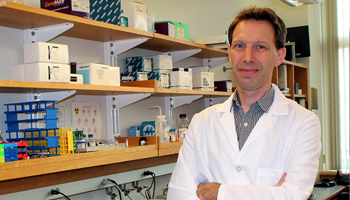 Christoph Seiler, PhD, director of the Aquatic Zebrafish Core.
Christoph Seiler, PhD, director of the Aquatic Zebrafish Core.
Christoph Seiler, PhD, director of the Aquatic Zebrafish Core, greets us on the other side and introduces us to a team of researchers and technicians who study and care for the zebrafish. The Core’s mission, he explains, is to consult with clients, both internal and external, and offer resources and training for them to work with zebrafish models themselves and share expertise on how to perform whole sets of analysis to answer scientific questions.
The majority of clients who contact the Aquatic Zebrafish Core have discovered a new disease variant in a patient and now want to model it in zebrafish, study its phenotype, and compare it to the human disease presentation. In a relatively short amount of time, they can work with this model to find drugs that can help overcome or alleviate the phenotype.
The rapid, five-day development of zebrafish — from cell to animal — enables scientists to image whole organs in vivo, perform time-lapse analysis, and behavioral analysis. Researchers can also complete drug screens simply by adding the drug to the water, as most are taken up through the skin, intestine, or the thin gill epithelium. The fast development of the fish also makes it easy to create knockouts and transgenic lines, enabling a straightforward way to analyze disease phenotypes.
Caring for the Zebrafish
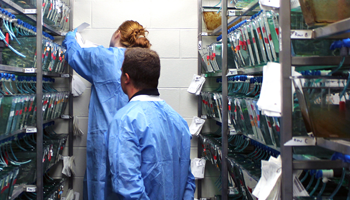 The zebrafish room with Margaret Brecker and Tyler Schubert inspecting their fish tanks for the Ronald Rubenstein, MD, PhD, Lab.
The zebrafish room with Margaret Brecker and Tyler Schubert inspecting their fish tanks for the Ronald Rubenstein, MD, PhD, Lab.
The Aquatic Zebrafish Core requires individuals involved in animal research to complete rigorous training on animal welfare principles, proper animal care, and their ethical and legal responsibilities, Dr. Seiler explains. There are about 500 tanks in here with sufficient space for several labs. The facility has the option to be expanded to 1,080 tanks. The water system is equipped with a fluidized bed biofilter and is fully automated, providing stable water conditions. Water is gathered from the tanks and manually tested on a weekly basis to ensure the ammonia/nitrate levels are balanced, as ammonia is toxic to fish. The alarm system minimizes risk to the animals, by alerting staff, night or day, to any problems.
Preparing Embryos
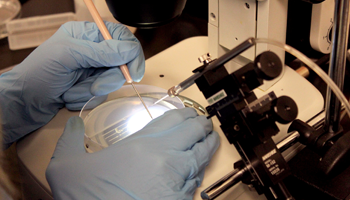 Adele Donahue, Zebrafish Core technician, preparing 80 zebrafish embryos, about 15 minutes old, in a dish.
Adele Donahue, Zebrafish Core technician, preparing 80 zebrafish embryos, about 15 minutes old, in a dish.
Nearly every project at the Core starts with an embryo injection to create a genetic model. The scientists can either knock out genes directly with CRISPR/Cas9, meaning every cell in the injected fish will carry a complete knockout of the targeted gene, or they can create a stable line in which the fish carry a defined mutation and then can be bred to obtain mutant larvae. For example, when scientists began to study the rare lymphatic condition mentioned earlier, they worked with zebrafish to better understand lymphatic vessel defects and fluid accumulation in tissues, and then they worked with these models to determine which drugs could prevent the phenotype.
Making Observations
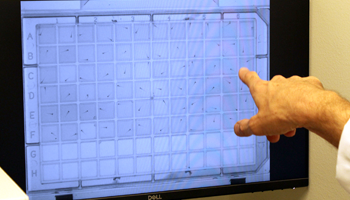 Dr. Seiler and the DanioVision Observation Chamber graph displaying the activity/behavior of zebrafish (control vs. tests).
Dr. Seiler and the DanioVision Observation Chamber graph displaying the activity/behavior of zebrafish (control vs. tests).
Let’s head upstairs to the Zebrafish Core Laboratory where zebrafish models of disease phenotypes are studied under high-powered microscopes and a behavioral observation machine. Heeyong Yoon from the Marni Falk, MD, Lab, is adding drugs to the water of zebrafish models of a mitochondrial disorder, an energy deficiency disorder for which no proven effective therapies exist. Next, he will observe their behavior under the microscope and the DanioVision Observation Chamber.
Zebrafish have a set of well-described and defined behavioral patterns, so activity is the most common feature to measure behavior. As you can see from the Observation Chamber graph, it compares behavioral changes in the test zebrafish models as compared to the control. The machine then assigns a score for activity (speed, velocity, frequency), revealing the efficacy of the drug being tested.
Well, that brings us to the end of our tour. The Zebrafish Core serves all researchers at CHOP and the University of Pennsylvania, and outside organizations too. A goal of the Core is to make these underwater superheroes accessible to everyone — from clinicians without their own labs to principal investigators with well-established projects.
If you would like more information on CHOP’s Aquatic Zebrafish Core, please contact Christoph Seiler, PhD.